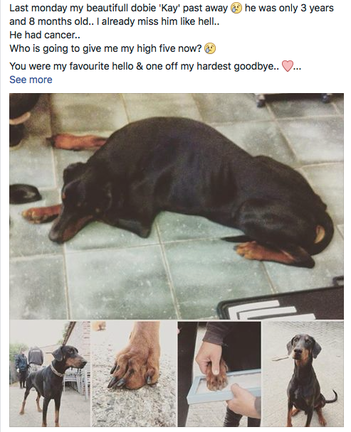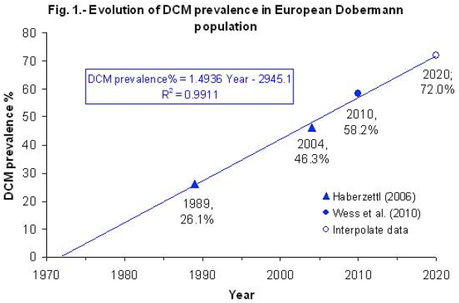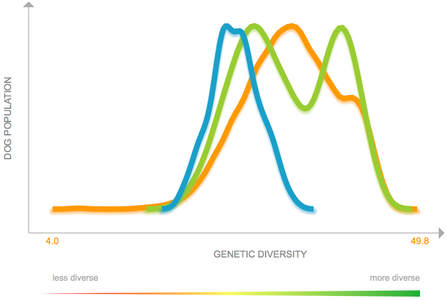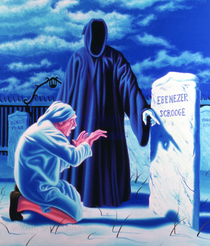Then just a few posts down there was this.
The dogs we love are dying. Biologists can tell you why this is happening, and in fact even animal breeders 100 years ago could have told you why this is happening. I've written dozens of blog posts on the ICB website explaining why this is happening.
Inbreeding affects health. At low levels of inbreeding, say 5% to 10%, there are effects on fertility, litter size, puppy mortality, and "vigor". There are also increases in the number of genetic disorders. The higher the level of inbreeding, the more negative the effects.
This is not folklore. This is fundamental, basic genetics. Inbreeding increases the expression of genetic disorders and has a negative effect on health in general. These are facts. If somebody is trying to convince you otherwise, you need to find a different mentor.
Inbreeding is necessary to fix type and improve consistency in domestic animals. This is how the breeds were created. These benefits can be appreciated at levels of inbreeding less than 10%.
Among purebred, recognized dog breeds, type was fixed long ago. The Dobermans above might not win in the ring, but they are recognizably Dobermans.
Here is the elephant in the room. Our dogs are dying of inbreeding. Decades of inbreeding in a quest for the ever more perfect dog has resulted in the loss of genes that are essential to life. However perfect and beautiful the dogs might be on the outside, on the inside they are broken.
What are we doing about this? We seem to be doing a lot. There are research studies, DNA tests, health seminars, disorder-specific Facebook groups, and so on.
But our dogs are dying of inbreeding. None of the things we are doing will cure inbreeding. Scientists can't cure inbreeding. Inbreeding must be cured by breeders.
I founded ICB four years ago because there was an increasing number of research papers being published about the negative effects of inbreeding on the health of dogs, but breeders didn't seem to be getting the message. There was really no place for breeders to go to get factual information, and they didn't have access to the resources and expertise they would need to address the growing problem. So ICB was born.
Four years on, thousands of students have taken ICB courses, but still it's just a trivial fraction of the number of breeders. A surprising number of ICB students are not breeders themselves, but are considering breeding in the future or are concerned about the growing health crisis in purebred dogs. For the most part, the "mainstream" breeders are not in these courses.
Perhaps this is why we seem to have settled into a standard approach in dealing with genetic disorders in dogs.
|
1) Dogs begin to turn up that suffer from some new disorder.
2) Breeders avoid breeding to dogs in the suspect lines. 3) Nevertheless, more dogs are afflicted and it becomes clear that the problem might be widespread. 4) Breeders acknowledge that there is a new genetic problem in the breed. 5) Breeders collect money and cheek swabs to initiate a research project to study the new disorder or to identify the faulty gene. 6) In the meantime, breeding continues and new cases continue to appear. 7) In the best case (but relatively rare) scenario, a single mutation is identified, a DNA test is developed, and a new test is added to the health screening list. 8) More often, a faulty gene is never identified, and study of the disorder does not offer useful insight into control measures. 9) The disorder is acknowledged as a "problem in the breed". 10) Breeding continues. Individual breeders adopt the strategies they believe will reduce their risk of producing affected animals (e.g., remove affected individuals and their close relatives from breeding; avoid breeding outside lines that are believed to be free of the problem). But nobody really knows what to do. 11) Eventually, a new problem will emerge and the cycle will repeat. (Note that I have left out the steps for rumors, finger-pointing, witch-hunting, and blame.) |
To the breeders, celebrity psychologist Dr Phil would ask "And how's this been workin' for ya'?"
The honest answer is that it's not.
What's the problem here? Breeders are looking to science for solutions to health problems, and the scientists study genetics and disease.
But the dogs are dying of inbreeding, and that is the problem we need to fix. We are focused on consequence when the solution lies in the cause. We are continuing to enjoy our cigarettes while we toss money at lung cancer research and assume that with hope, prayer, and patience things will get better. We are learning a lot about the problems that are caused by inbreeding, but we are not solving the problem.
Look into the future. What scenario do you envision for how this will end?
Science can help you with this. Doberman lover and scientist Dr Sonia Garcia Herdez put the information together to do a projection. Using published information about the frequency of DCM (dilated cardiomyopathy) in Dobermans, she created this nice graph of the known and projected frequency of the disease.
The graph is a frequency distribution of "heterozygosity". Heterozygosity is the fraction of loci in a dog's genome that have two different alleles. Inbreeding decreases heterozygosity; that is, inbreeding increases homozygosity, meaning both alleles are the same because an animal inherited the same allele from both parents. On the graph, the dogs with the lowest inbreeding are to the right and those with the highest inbreeding are to the left, indicated by the color scale from green to red under the graph. The orange line on this graph is for "all dogs" in their database and the green line is for a selection of similar breeds (pinschers, schnauzers, etc).
The blue line is for Dobermans and includes dogs from the US, UK, Finland, Russia, Australia, and Ukraine. The median level of heterozygosity reported by MDD for Dobermans is 27% (that should be close to the peak in the blue line). This is quite a bit lower than the median for all dogs, and it's even worse than the comparison population.
But is this really all that bad? Have a look at the graph below.
I have compiled the data for median heterozygosity of most of the breeds in the MDD database, and they are ranked here from worst (left) to best (right). The Doberman is indicated by the red arrow, well down in the rankings. (You can download a larger version of this graph below.)
| _doberman-_mdd_genetic_diversity_by_rank_copy_3.png |
|
In A Christmas Carol, Scrooge is spirited into the future, where he sees how the consequences of his actions have affected many lives. The grim picture is enough to get him to change his ways and become a better man.
Unless there is some unanticipated scientific breakthrough, the future of the Doberman is grim. Dogs will continue to be snatched from life by sudden heart failure, and owners will continue to come home from work to find their dog dead on the floor. The Doberman DCM Facebook group will continue to grow. The Rainbow Bridge will widen to accommodate the souls of the dogs that are dying too young. |
DNA testing does not make somebody a "responsible" breeder. Caring for the heritage of your breed does not make you a "preservation" breeder. Pride and love and dedication are all terrific, but they will not prevent the heartbreak that awaits thousands of Doberman owners in the future. Breeders need to DO something about this. Breeders need to step up to the plate and acknowledge that continuing to breed dogs that are likely to die of a genetic disorder is irresponsible, unethical, and inhumane. That is certainly how the average, everyday dog lover feels. This is also how I feel.
How many of you just read the last paragraph and thought to yourselves "But breeders will never do it". Really? Not the "responsible" breeders? Not even the "preservation" breeders? Is there nobody who loves this breed enough to save it?
Go back and watch that video of the Doberman dropping dead in the middle of a game of fetch. Where are the breeders - those most devoted Doberman lovers - who will do something about this? This isn't my breed, but it's breaking my heart.
If you're thinking that you're glad you aren't a Doberman breeder, you should have a look at the data for your own breed. There are unfortunately many breeds in which dedicated (responsible, preservation) breeders are likewise pursuing solutions by supporting research to study the health condition or searching for causative genes. Huge sums of money are being spent, breeders are becoming experts about esoteric veterinary disorders, and Facebook is burgeoned with groups for information, commiseration, and condolences.
But the path is the same, and the consequences probably are too. There is only one way to cure the diseases that result from inbreeding. Breeders are the only ones that can fix this. The problems have become obvious and undeniable in many breeds: Berners, Goldens, Flatcoats, Irish Water Spaniels, Cavaliers, Akitas, Dogue de Bordeaux, Bulldogs, Scotties, Westies, and the list goes on.
There are a lot of breeds in trouble, with high inbreeding, low diversity, a growing list of genetic disorders, and plans to start another research study.
Science can learn about the problems caused by inbreeding, but the "cure" for inbreeding will have to come from the breeders. If you want to preserve your breed, this is the problem you need to address.
To learn more about the genetics of dogs, check out
ICB's online courses
***************************************
Visit our Facebook Groups
ICB Institute of Canine Biology
...the latest canine news and research
ICB Breeding for the Future
...the science of animal breeding






